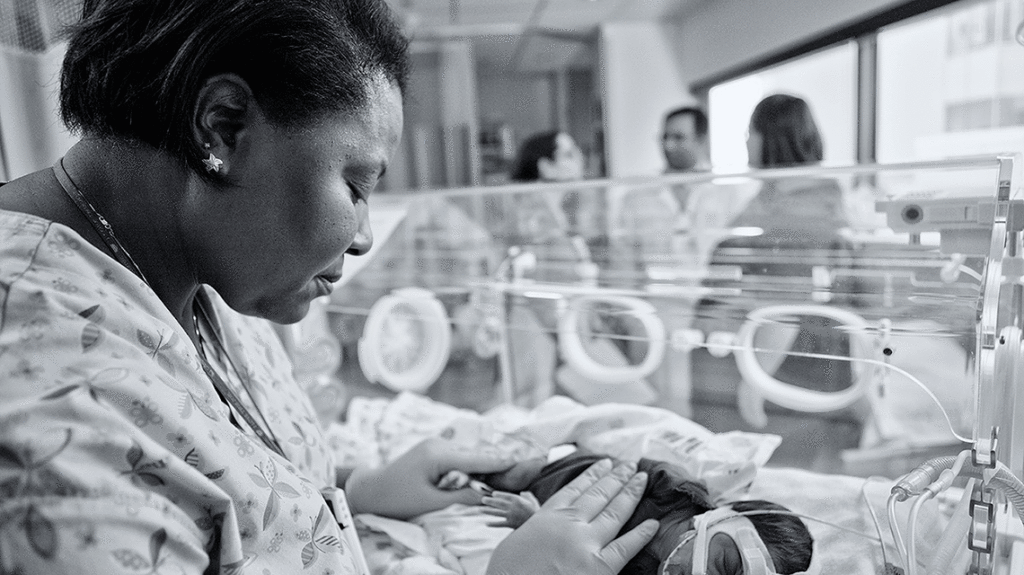Bronchopulmonary Dysplasia: Characterizing the Chronic Lung Disease of Prematurity
Bronchopulmonary Dysplasia: Characterizing the Chronic Lung Disease of Prematurity https://pediatricsnationwide.org/wp-content/uploads/2021/02/022812ds391HRBW_NICU-for-web-header-1024x575.gif 1024 575 Lauren Dembeck Lauren Dembeck https://pediatricsnationwide.org/wp-content/uploads/2021/03/Dembeck_headshot.gif- July 06, 2021
- Lauren Dembeck

Precise definitions and/or classifications of bronchopulmonary dysplasia are needed to optimize outcomes.
Researchers at Nationwide Children’s Hospital are continuing to help refine the definition of severe bronchopulmonary dysplasia (sBPD). In a recent study, members of the BPD Collaborative demonstrated that preterm infants with sBPD who were on invasive mechanical ventilation at 36 weeks, a criterion proposed in some newer definitions of BPD, had a significantly greater risk of in-hospital mortality and those who survived had a significantly greater risk of undergoing tracheostomy and/or gastrostomy. The findings were published in the Journal of Perinatology.
The BPD Collaborative comprises sites interested in the care and outcomes of sBPD and who have established interdisciplinary care programs for the management of patients with sBPD. In the study, the team used the cohort to examine how the BPD Collaborative modification of the 2000 National Institutes of Health (NIH) Consensus Statement definition of sBPD compares with two recently proposed definitions of BPD, the 2016 National Institute of Child Health and Human Development (NICHD) workshop definition and the Neonatal Research Network (NRN) definition.
“BPD is the most common complication of prematurity. It is a big problem not only for our patients and their parents but also for our health care system, and its incidence is increasing,” says senior study author Leif Nelin, MD, who is division chief of Neonatology at Nationwide Children’s. “Having a better understanding of what the disease looks like and how it progresses is going to be really important for devising novel therapies and improving outcomes for these patients.”
The observational study leveraged data from the BPD Collaborative Registry. Between January 2015 and September 2019, 564 patients with sBPD according to the 2000 NIH consensus definition were identified. Of those, 24% were on invasive mechanical ventilation at 36 weeks post-menstrual age—Type 2 sBPD according to the BPD Collaborative modification. Compared with patients who were on noninvasive support, these patients had more total ventilator days, longer length of stay, and more frequent treatment with diuretics, β-agonists, or corticosteroids, and they were 6.6 times more likely to receive tracheostomy and 2.1 times more likely to require gastrostomy. The overall mortality rate was 3%. Those on invasive mechanical ventilation had a 13.8 times greater risk for mortality than in those on noninvasive support.
When applying the other BPD definitions to the cohort, under the 2016 NICHD definition, 26% had Grade I, 26% had Grade II, 42% of patients had Grade III, and 6% were non-classifiable; under the 2019 NRN definition, 6% had Grade 1, 70% had Grade 2, and 24% had Grade 3.
Their findings suggest that the use of the BPD Collaborative modification to NIH definition of Type 2 sBPD or NRN definition of Grade 3 BPD would enhance the ability identify those infants with sBPD at the highest risk of adverse long-term outcomes, which would allow for more targeted future studies.
“Where this will have the biggest effects are in those patients that have the worst in-hospital outcomes. Being able to identify those patients at highest risk relatively early, at 36 weeks post-menstrual age, is critical for implementing therapies to improve outcomes,” says Dr. Nelin.
The investigators plan to begin searching for molecular biomarkers that correlate with outcome to complement clinical data for the development of a prediction score for infants with sBPD.
“There are more data coming out to suggest that BPD is a lifelong disease. Trying to identify those patients who are going to be most symptomatic through childhood and maybe even into adulthood is going to be really important going forward,” says Dr. Nelin.
Reference
Guaman MC, Pishevar N, Abman SH, Keszler M, Truog WE, Panitch H, Nelin LD. Invasive mechanical ventilation at 36 weeks post-menstrual age, adverse outcomes with a comparison of recent definitions of bronchopulmonary dysplasia. Journal of Perinatology. 2021 May 25. {Epub ahead of print.]
About the author
Lauren Dembeck, PhD, is a freelance science and medical writer based in New York City. She completed her BS in biology and BA in foreign languages at West Virginia University. Dr. Dembeck studied the genetic basis of natural variation in complex traits for her doctorate in genetics at North Carolina State University. She then conducted postdoctoral research on the formation and regulation of neuronal circuits at the Okinawa Institute of Science and Technology in Japan.
-
Lauren Dembeckhttps://pediatricsnationwide.org/author/lauren-dembeck/
-
Lauren Dembeckhttps://pediatricsnationwide.org/author/lauren-dembeck/
-
Lauren Dembeckhttps://pediatricsnationwide.org/author/lauren-dembeck/
-
Lauren Dembeckhttps://pediatricsnationwide.org/author/lauren-dembeck/January 29, 2019
- Post Tags:
- BPD
- Neonatology







